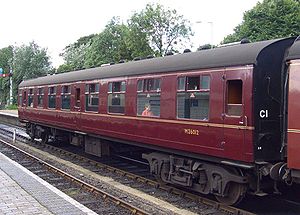- Standard Corridor
-
British Rail Second Corridor 
A Mk1 Second Corridor (SK) coach at the North Norfolk Railway in 2007In service 1951– Manufacturer BR Ashford/Easteigh, Derby (C&W), Doncaster, Swindon, Wolverton, York, BRCW, Cravens, GRCW, & Metro Cammell Family name British Railways Mark 1 Constructed 1951–1963 Number built 2168 Fleet numbers 24000–25507, 25510–26217 Capacity 48 with armrests
64 withoutOperator British Rail Specifications Car length 64 ft 6 in (19.66 m) Width 9 ft 3 in (2.82 m) Height 12 ft 9 1⁄2 in (3.90 m) Doors Manual slam doors, three per side Maximum speed BR1/Cw: 90 mph (145 km/h)
B4: 100 mph (161 km/h)Weight 32.5 long tons (33.0 t) to 36.5 long tons (37.1 t) Train heating Steam or electric heat, or both Bogies BR1, Commonwealth or B4 Braking system(s) Vacuum, air, or both Coupling system Drop-head knuckle coupler on draw-hook Gauge 4 ft 8 1⁄2 in (1,435 mm) The Standard Corridor (previously Third Corridor) type of railway carriage was one of the standard mid-20th century designs, and was coded SK (previously TK) by the LNER and BR, and CF by the LMS. The layout of the coach was a number of compartments, all of which were standard class (known as third class until the 1960s), linked by a side corridor.
The British Railways produced Mark 1 SK was the most numerous carriage design ever built in the United Kingdom. The original number series carried was 24000–26217. From 1983, those carriages in the 25xxx and 26xxx series were renumbered 18xxx and 19xxx.
There were two variants, those built for the Midland, Scottish, and Eastern / North Eastern regions had six seats per compartment, with fold-up arm-rests which folded into the seat-back, while those built for the Southern and Western regions, with their heavy commuter loadings into London, had eight seats in each compartment, and no arm-rests. Seating was of the interior sprung bench type. Over time, some SKs and BSKs were re-allocated from other regions to the Western, who tended to try and stitch the arm-rests in the up position.
In the 1980s, a number of Mark 2 First Corridor carriages were declassified to become SKs. They were renumbered from 13xxx to 19xxx, putting them after the end of the Mark 1 range (19452–19557).
No carriages of this type are still in daily use on the main line network, since open saloon carriages are now preferred by operating companies. However, some electric multiple units based on Mark 1 coaches have standard class compartments. Many SKs still operate on preserved UK railway lines.
Corridor Brake Standard/Second
A standard corridor coach with a guard's brake compartment is designated BSK. The Mark 1 BSKs had 4 compartments, built two two variants with or without arm-rests depending on region, as with the SKs.
See also
Coaching stock of British Rail Passenger coaches Mark 2:BFO · CO · FO · RFM · SLE · SLED · SLEP · TSO · TSOB - (Locomotive hauled)
TF · TGS · TRB · TRFB · TRFK · TRSB · TS - (InterCity 125 trailers)Other Mark 1:Categories:- British Rail coaching stock
Wikimedia Foundation. 2010.
